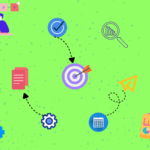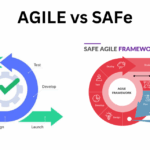Home / Our Blog / What is a Product Roadmap, Why It Matters, and How to Build One
What is a Product Roadmap, Why It Matters, and How to Build One
Aug 05, 2025 Educational
A product roadmap is a simple plan that shows how a product will grow and improve over time. It helps teams stay on track by showing what features are coming, when they’ll be delivered, and why they matter. Product managers and owners use it to guide their teams and keep work aligned with business goals.
If you’re working in an agile environment, a roadmap gives your team daily clarity and helps adjust plans as things change.
What is a Product Roadmap?
A product roadmap is a clear visual guide that explains the goals, timeline, and direction of a product. It shows what the team is working on now, what’s coming next, and what’s planned for the future.
But a good roadmap does more than list features. It also shows why those features matter. Each item should connect to your strategy, customer needs, and company goals. It’s a living document that can adapt to feedback and market changes.
Agile teams use roadmaps to stay aligned, prioritize tasks, and understand how their daily work fits into the bigger picture.
Who Uses Product Roadmaps?
Different teams use different types of roadmaps. Here’s a breakdown:
1. Development Team Roadmap
This version is detailed and includes customer priorities, release dates, and milestones. It helps developers understand the strategy behind their work. The actual tasks and sprints are usually tracked separately but should match the roadmap.
2. Executive Roadmap
Executives need a high-level view. This roadmap shows how team efforts support big company goals. It’s often organized by quarters or months and focuses more on progress than technical details.
3. Sales Team Roadmap
Sales teams use roadmaps to talk to customers about what’s coming next. These maps highlight benefits and upcoming features but avoid exact delivery dates to prevent false promises.
4. Customer-Facing Roadmap
This version is public or shared with clients. It shows exciting future plans in a simple, visual format. It helps build trust and keeps users interested in your product’s future.
Why Are Product Roadmaps Important?
A product roadmap is more than a plan — it’s a communication tool.
- For company leaders: It shows how features align with goals and helps track progress.
- For product teams: It brings different teams together and clarifies priorities.
- For developers: It gives a clear view of what’s important, reducing confusion and helping quick decision-making.
How to Create a Product Roadmap
Creating a product roadmap doesn’t have to be hard. It just needs to be clear, organized, and goal-driven. A good roadmap helps your team know what to build, why it matters, and when it should be delivered.
Here’s a step-by-step process to create a product roadmap that works:
Step 1: Define Your Product Vision and Goals
Before you build anything, you need a clear product vision. This is your “big picture” — what you want your product to become in the future.
Then, break this vision down into specific goals. These should match your company’s business objectives.
Ask yourself:
- What problem are we solving?
- Who are our target users?
- What business goals are we supporting?
Example: “We want to improve onboarding to reduce churn by 20% in the next 6 months.”
Step 2: Gather Inputs and Insights
Next, collect feedback and data from different sources:
- Customer feedback
- Sales and support teams
- Market trends
- Analytics and usage data
- Internal stakeholders
This helps you understand what users need and what features will have the most impact.
Step 3: Prioritize the Features and Ideas
Now, choose which ideas are most important.
Use simple prioritization methods like:
- ICE scoring (Impact, Confidence, Ease)
- RICE (Reach, Impact, Confidence, Effort)
- Value vs Effort matrix
Focus on features that:
- Solve real problems
- Fit your goals
- Are possible within your resources
Keep it lean. Not every idea needs to go on the roadmap right away.
Step 4: Choose a Roadmap Format
Pick the roadmap format that best fits your audience. Common types include:
- Timeline view: Shows when things will happen
- Now, Next, Later: Keeps things flexible and agile
- Goal-based view: Groups features by business outcomes
- Kanban-style board: Visual, drag-and-drop format for agile teams
Step 5: Build Your Roadmap
Now it’s time to actually create the roadmap. Add your chosen features and group them based on time or priority.
Include:
- Feature name
- Description
- Goal it supports
- Priority level
- Status (planned, in progress, done)
- Expected release (if known)
Keep the design clean and simple. Use color codes or labels to make it easy to scan.
Don’t forget to add high-level goals at the top to keep everyone aligned.
Step 6: Share and Review with Stakeholders
Before you finalize your roadmap, show it to key stakeholders:
- Executives
- Developers
- Sales teams
- Customer success
Make sure everyone understands the roadmap and agrees with the direction.
Ask for feedback:
- Are any features missing?
- Are the goals clear?
- Does the timeline look realistic?
Use their input to make improvements.
Step 7: Link the Roadmap to Delivery Plans
Once your roadmap is approved, connect it to the work being done.
Break each feature into smaller tasks:
- Epics
- User stories
- Sprints
Track progress in Scrum Slate or your project management tool to make sure everything stays aligned.
The roadmap gives the “what” and “why.” Your delivery plan shows the “how.”
Make sure the roadmap matches your audience:
- A roadmap for developers might focus on one product.
- A roadmap for leadership might show plans for multiple products.
- A roadmap for customers should be clear, friendly, and high-level.
Tip: Don’t overcomplicate it. Too much detail can be confusing. Keep it clean and easy to understand.
How to Share and Present Your Roadmap?
Two groups need to be on board: your leadership team and your development team. Use your roadmap presentation to show that you understand customer needs, company vision, and how your plan fits both.
As work moves forward, link tasks back to the roadmap. Break down big ideas into:
- Epics
- User stories
- Requirements
Doing this in Scrum Slate makes it easy to track tasks and stay connected to the big picture.
Keeping Your Roadmap Updated
A roadmap should grow with your product. As customer needs change or market trends shift, update your roadmap. Don’t let it get outdated — it should always show your current and future plans.
How often should you update it? Weekly or bi-weekly updates work for most teams. If stakeholders start asking for updates instead of checking the roadmap, it’s a sign it’s not up to date.
But don’t overdo it. If you’re spending more time updating than building, change your update process. Focus on collecting feedback efficiently and using it to improve your roadmap.
Best Practices for Product Roadmaps
Want your roadmap to be useful and effective? Follow these simple tips:
- Only add details that your audience needs
- Balance short-term work with long-term goals
- Review and adjust your roadmap regularly
- Make sure everyone can access and use it
- Communicate often with all stakeholders
Start Building Your Roadmap with Scrum Slate
Ready to build your own product roadmap? Use Scrum Slate to create, share, and update your roadmap easily. Start free and align your whole team around a clear, simple plan.









